The climate in Florida makes it the perfect habitat for wasps throughout the year, making it likely you will encounter a wasp on any given day. They build their net around homes, under porches, and any area that is sheltered from the elements.
We have put together a list of the 42 common wasps in Florida from the most common to the least common, helping you identify the wasp you may have encountered in your home or yard.
1. Horse’s Paper Wasp
The horse’s paper wasp (Polistes major) is a large wasp that can grow to 0.87 inches (22mm) in length with a 1.8 inch (45mm) wingspan. They are yellow with brown markings.
The queen will very seldom leave the nest, which they are responsible for making.
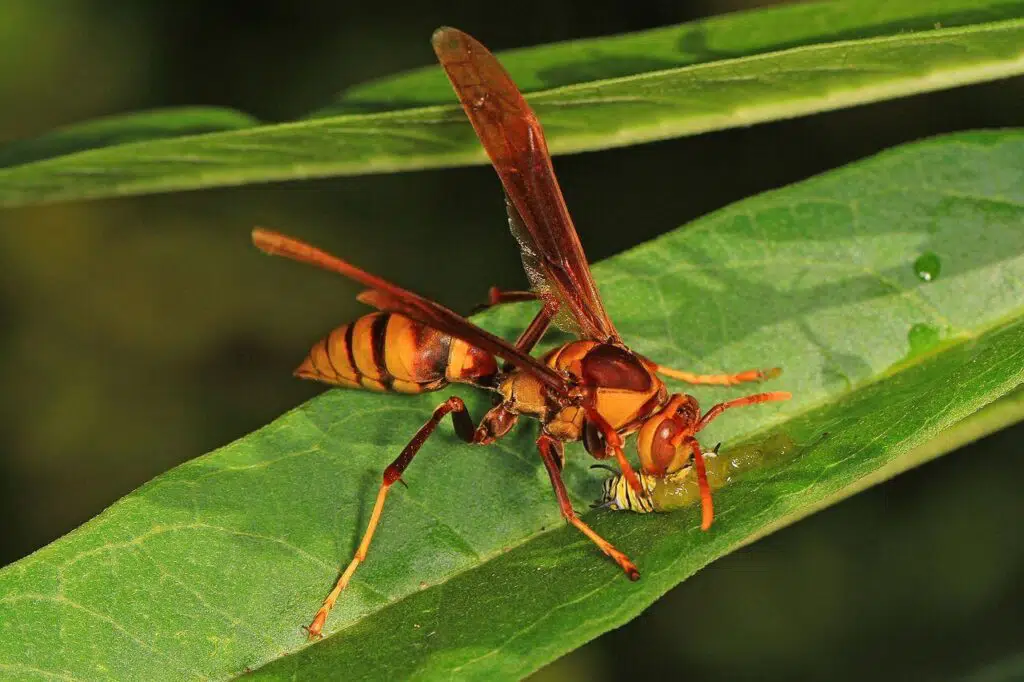
The nest comprises a gray or paper brown material, which is constructed from chewed wood into an open comb, which contains multiple cells. The nests are usually found under window frames, roofs, branches, leaves, palm tree leaves, and bridges. The nests are around 19cm in diameter.
2. Hunter’s Little Paper Wasp
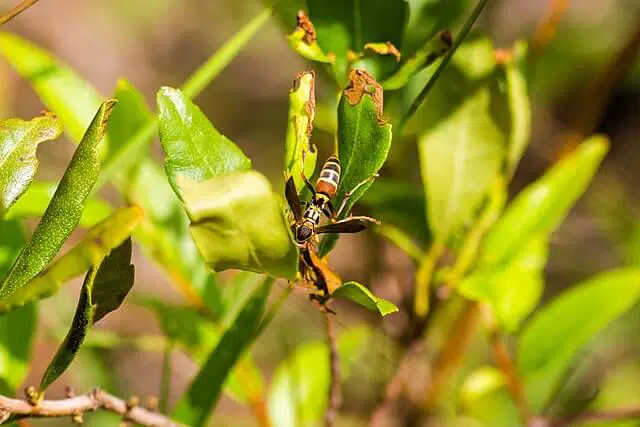
The hunter’s little paper wasp (Polistes dorsalis) is a small wasp that has an exoskeleton plate that looks like a black with a yellow-colored shield and elongated antenna.
They built their nests in sheltered and private areas, making them harder to find. They choose rock piles, hollow logs, and sites close to the ground. In urban areas, you can find their nests below roof borders or within shrubbery. They create small nests that house up to 75 adult wasps.
3. Feather-legged Scoliid Wasp
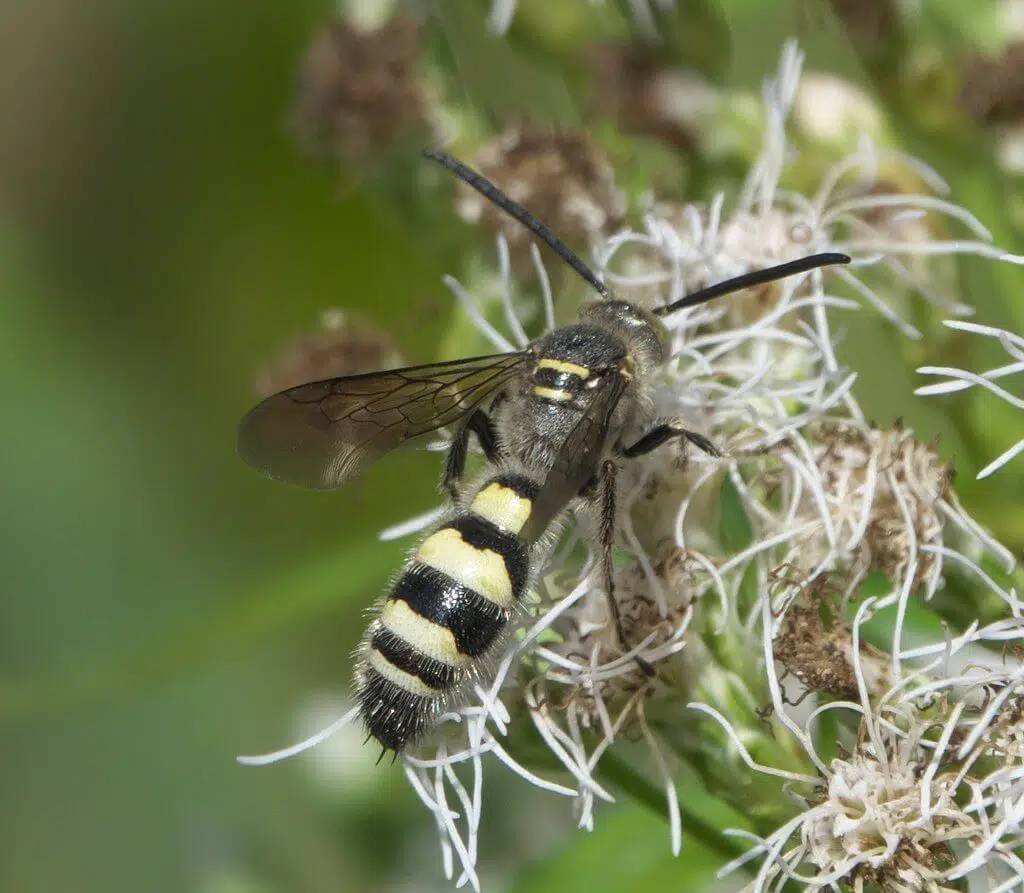
The feather-legged scoliid wasp (Dielis plumipes) grows to around 25mm and is considered medium-sized with yellow or cream/white abdominal bands. Males have longer antennae than females.
They are beautiful wasps and widespread. They are docile and solitary with the females keeping nuisance beetles under control.
They are great pollinators with the feathers on their limbs picking up pollen, which they distribute as they hover from one flower to the next in search of sweet nectar.
4. Metric Paper Wasp
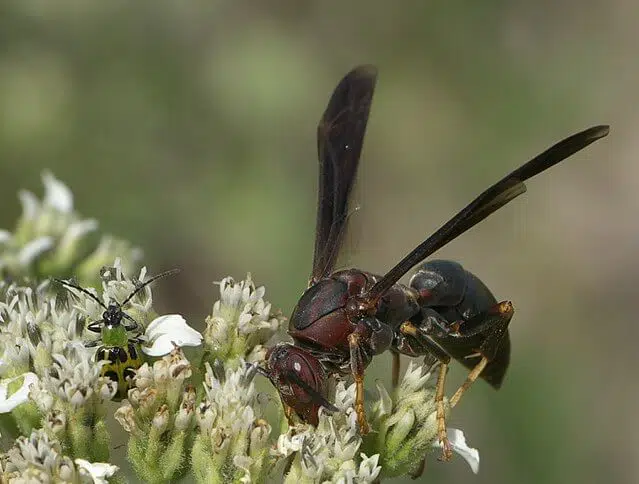
The metric paper wasp (Polistes metricus) is a dark rusty colored wasp with black markings in the thorax and the abdomen is mostly black. The tibias are black with yellow tarsi.
Females have six abdominal segments and males have seven. Females have more rusty red coloration on the head and mesosoma with yellow markings being limited. Males have less red coloration and more black coloration with more yellow than females.
Nesting sites are chosen with care to ensure they are sheltered from the elements. They build nests in barns, sheds, and under eves, in large and well-lit areas. They are never far from water, such as bonds, which they use for hydration.
5. Mexican Paper Wasp
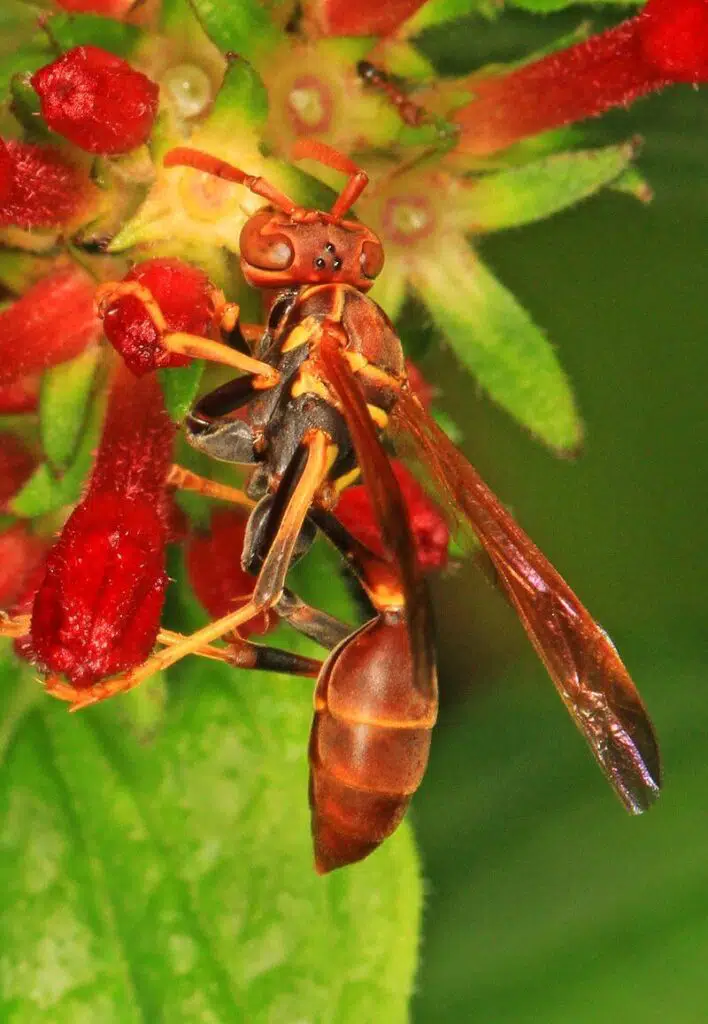
Mexican paper wasps (Mischocyttarus mexicanus) have asymmetrical internal and external lobes on their tarsal segments. They are known for their sharp secondary margins on their pronotum, the dorsal surface of the prothorax. Males have short thick antennae. They are orange to yellow in color.
Their nests are common in cabbage palms, oak trees, Spanish moss, and human constructions.
6. Red-marked Pachodynerus Wasp
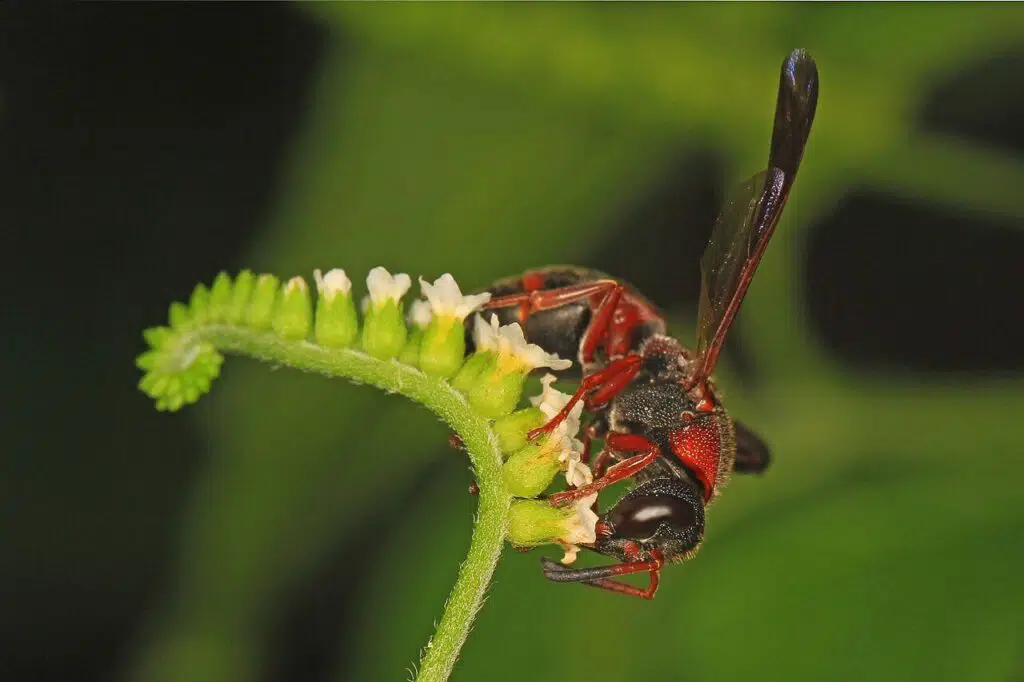
The male and female red marked Pachodynerus wasp (Pachodynerus erynnis) have similar coloration except the male has a white to yellow pentagonal spot on the face. Females have red coloration in the same area of their heads.
They are pollinating wasps, feeding on flowers nectar. They build nests out of dry soil and saliva, which creates a type of mud. They are known to tunnel their way through the mortar between bricks, creating shelter for their young.
7. Southern Yellowjacket
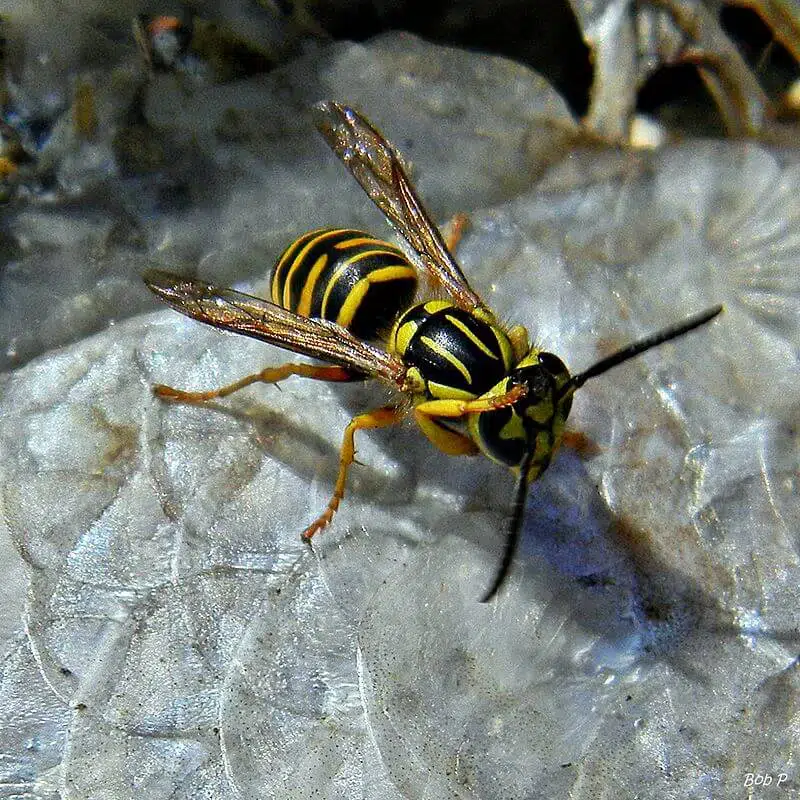
The southern yellowjacket (Vespula squamosa) is a social wasp, which is easily identified with its black and yellow patterning, along with an orange queen. They grow to around 0.5 inches (1.3cm) in length with clear wings and hairless bodies. The queen is larger than the males and workers with orange coloration.
Their nests are often seen in unnatural habitats, such as parks, the side of the road, and yards. They are also found in pine forests. Their nests are made up of chewed vegetable fibers with colonies containing up to 450,000 cells. The largest nest reported was 45 inches (114.3cm) in diameter containing 39 cones.
8. Noble Scoliid Wasp
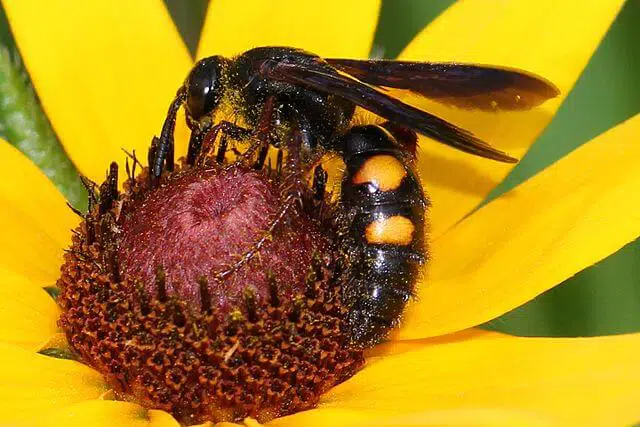
Noble scoliid wasps (Scolia nobilitata) are beetle hunters, they are solitary wasps with the female digging in the soil in search of beetles. They have a curled posture.
The noble scoliid wasp is a small wasp that grows to half an inch in length with red-colored legs and dark wings. Females have up to three yellow or orange spots o the front of their abdomen, while males are more variable in color, usually with yellow banding on their abdomens.
9. Yellow-legged Mud-dauber Wasp
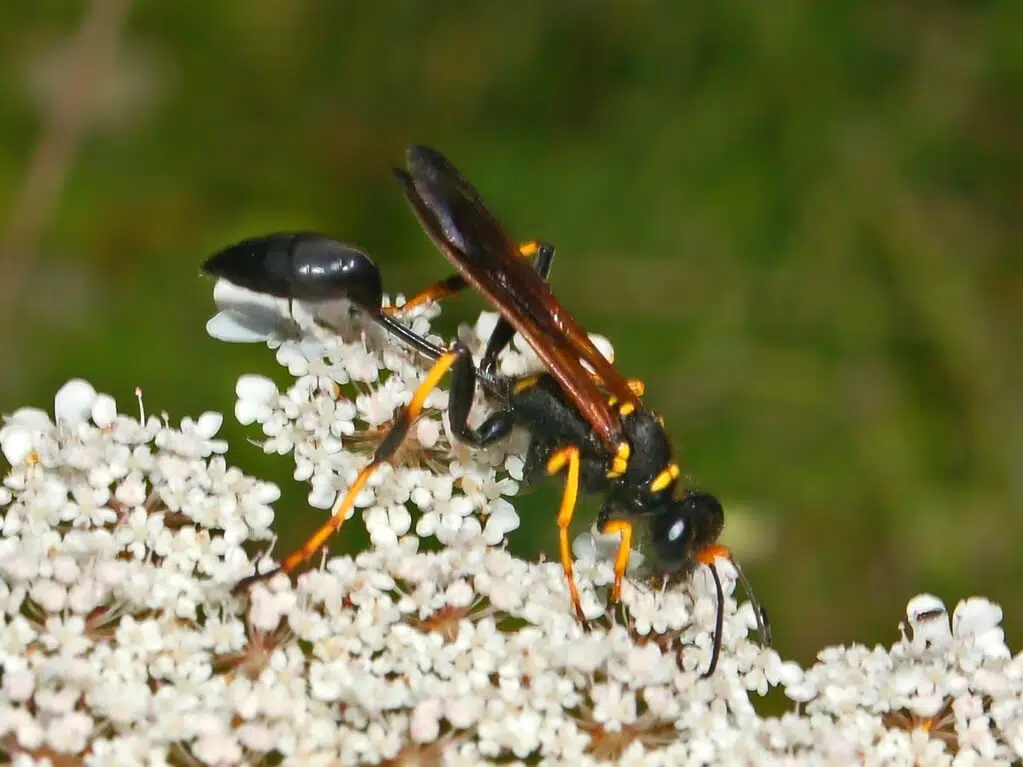
The yellow-legged mud dauber wasp (Sceliphron caementarium) can grow to 1.10 inches (28mm) in length. They have black petiole, which is around half the length of the abdomen. Their thorax has yellow markings with a black abdomen and yellow propodeum. The legs are yellow with black femurs.
They are the only wasp species in the United States with yellow marking o their legs, making them easier to identify.
These wasps are solitary parasitoid wasps and create their net out of the mud. They collect mud balls at the pool edge and puddles to construct their nest, which is built in a shaded area, with protection from the elements.
They are often found in natural and man-made structures, such as under bridges, in barns and garages, and under the eaves of homes.
10. Three-banded Scoliid Wasp
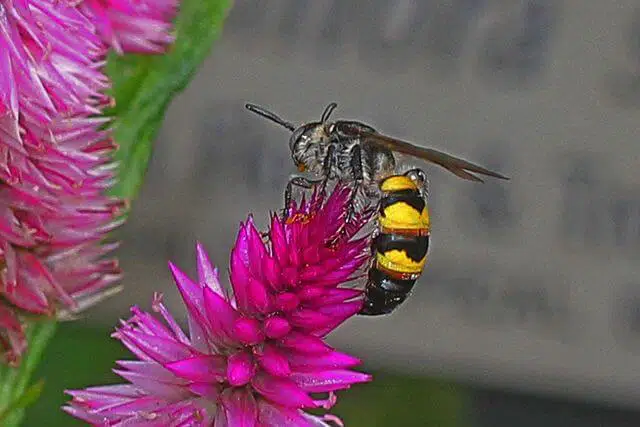
The three-banded scoliid wasp (Dielis trifasciata) is distinguished with its bright yellow to orange colored stripes.
Females will only have three abdominal bands. Males and females grow to around 15mm in body length with a stable color and pattern.
These are large stout-bodied wasps. They are parasitoids and hunt after soil-inhabiting scarab beetle larvae.
Males are often flying close to the ground, while females land and dig with their mandibles into the soil.
11. Dark Paper Wasp
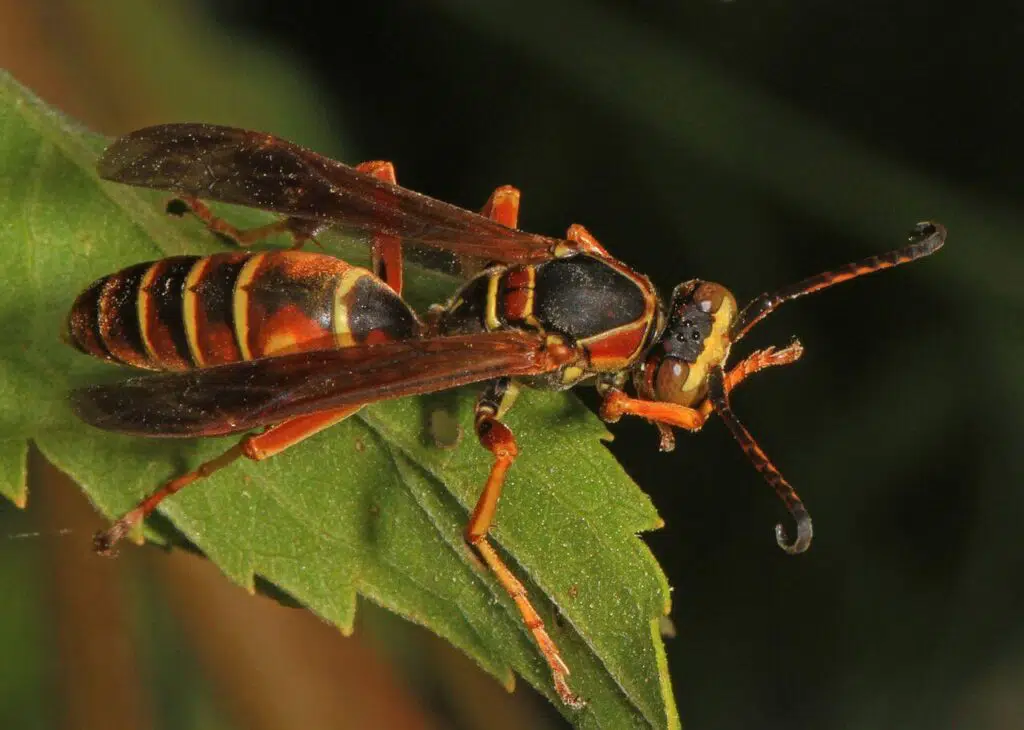
Dark paper wasps (Polistes fuscatus) nest in woodlands and savannas and are common in human habitats, especially if there is any wood exposed that could be used as nesting material.
These wasps grow to 21mm in body length and are slender with dark red/brown color with yellow banding.
They have pointed heads and males have curves at the tip of their antennae and more yellow coloration on the front o the head.
Their diet comprises mostly of plant nectar, though they are insectivores and eat caterpillars and other small insects.
12. Guinea Paper Wasp
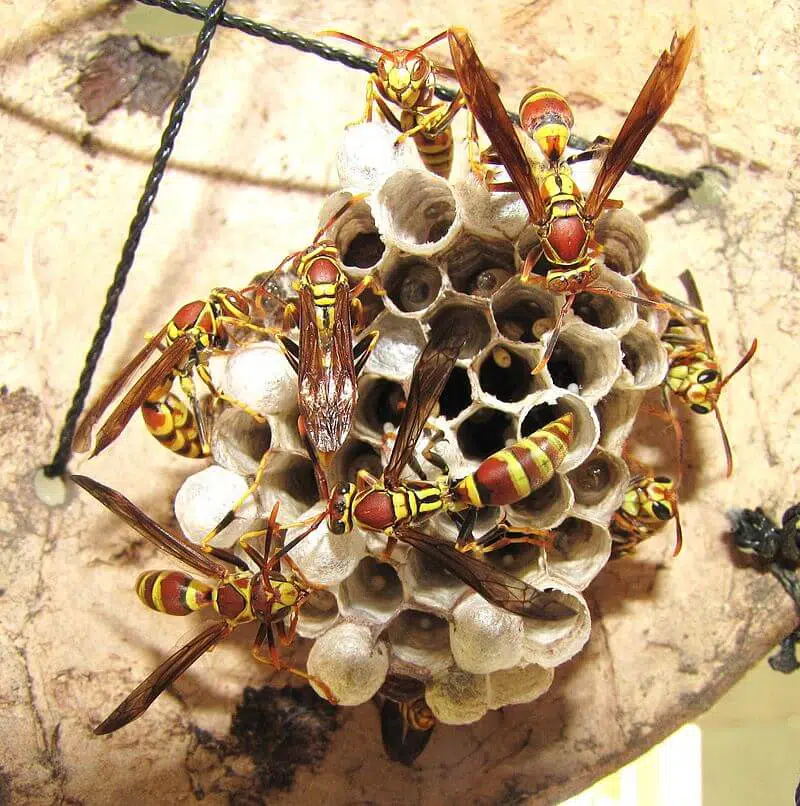
Guinea paper wasps (Polistes exclamans) always have some yellow coloration with yellow on the head. Their wings have purple coloration. The antennae are banded with yellow, black, and red.
Females have a fore wing length of up to 16.5, while males have a fore wingspan of 15mm.
These wasps are known for creating satellite nests, where the queen flies up to 11m from the original nest and settles in a new location. Up to 39 percent of the nests created between May and July are satellite nests.
13. Polistes bellicosus
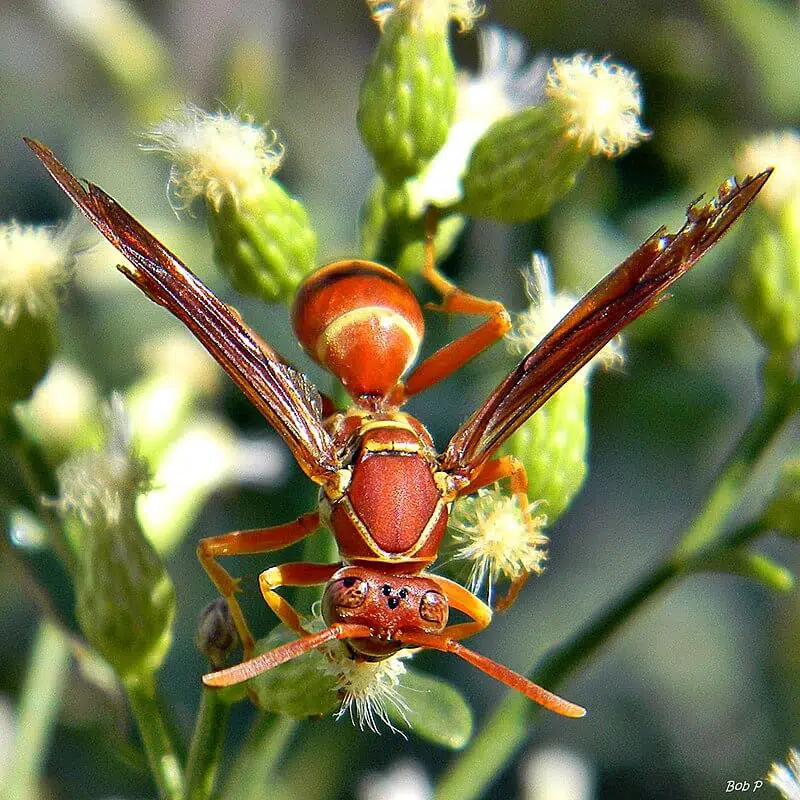
The male and female Polistes bellicosus have lemon yellow abdominal segments with females having a central longitudinal black line on the mesothorax.
Males have two longitudinal lines on the side of the mesothorax. The males and females have yellow mandibles.
They manufacture paper for their nests using small fibers from exposed and weathered wood. They use their mandibles to compress the wood into sheets which are used as cells. The opening of the nest is located at the bottom.
14. Eastern Cicada-killer Wasp
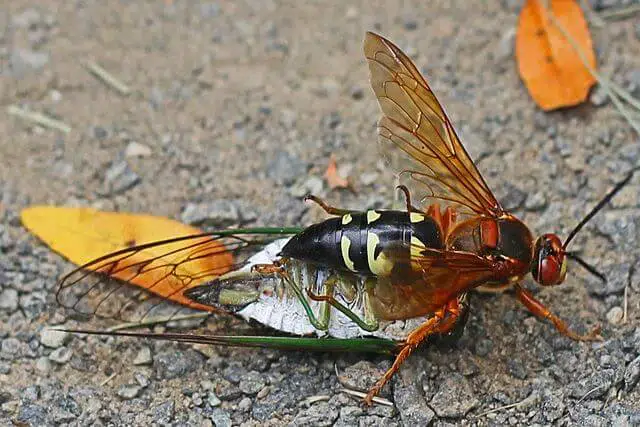
The eastern cicada killer wasp (Sphecius speciosus) is a large solitary digging wasp, belonging to the Crabronidae family. They are sometimes referred to as sand hornets, but they are not hornets.
Adults are large, growing to 2 inches (5cm) in length with red and black areas on the middle section, which is also hairy.
They are black to reed/brown on their abdomens with light yellow stripes. Their wings are brown in color.
They are often found in well-drained and sandy soils, grass-covered bands, hills, and raised sidewalks. They can burrow up to 20 inches (50cm) deep and around 0.59 inches (1.5cm) in diameter.
Females have special spines on their hind legs, which helps her push the loose soil behind her as she digs the nest using their jaws.
They are known to nest in window boxes, planters, flower beds, and under shrubs. Their nests are usually located where vegetation is sparse with full sun exposure.
15. Fraternal Potter Wasp
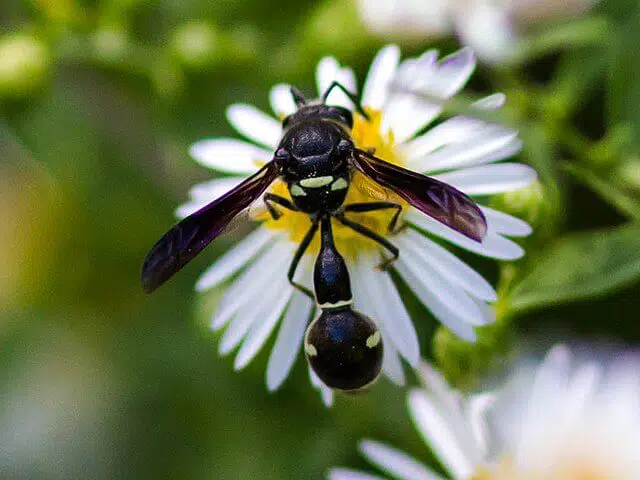
Female fraternal potter wasps (Eumenes fraternus) build a tiny pot of mud, where she lays an egg and places a live caterpillar for the developing larvae to feed on. She then puts a lid on the pot and goes to make another pot.
Adults feed on nectar.
They have a long and slender first abdominal segment and can grow to 0.8 inches (20mm) in length. They are black with ivory-colored markings. Their fore wings can grow to 12.5mm in females and 10.5mm in males.
16. Large Four-spotted Scoliid Wasp
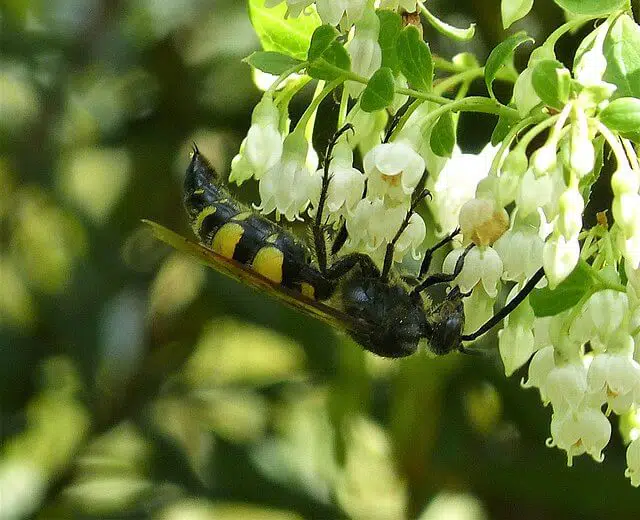
The large four-spotted scoliid wasp (Pygodasis quadrimaculata) can grow to 35mm and is a large wasp with four spots on the female abdomen and males being variable in pattern. They have black legs and the males have a unique wing vein pattern.
Females can be easily identified by their four orange spots. Males can vary from two to three yellow spots with or without yellow banding.
17. Blue-eyed Ensign Wasp
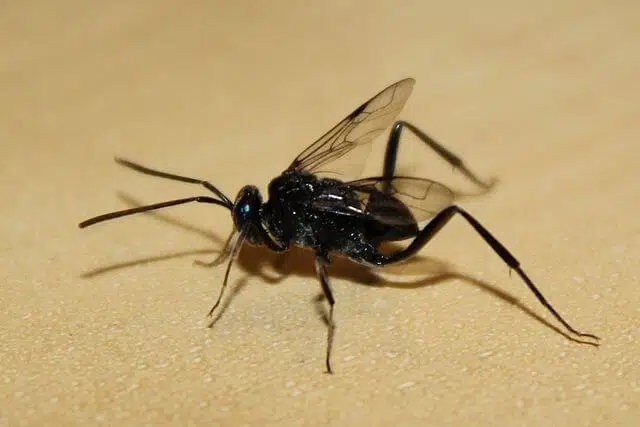
Blue-eyed Ensign wasps (Evania appendigaster) belong to the Evaniidae family and their native range is still unknown, though they are believed to have come from Asia.
They are parasitoid and are known for specializing in cockroach eggs.
They are one of the larger ensign wasps with a 7mm fore wingspan. They have a black body with blue eyes. They have a constricted abdominal petiole, which is oval to triangular in shape, which is held in a flag-like position, resembling an ensign.
18. Larra bicolor
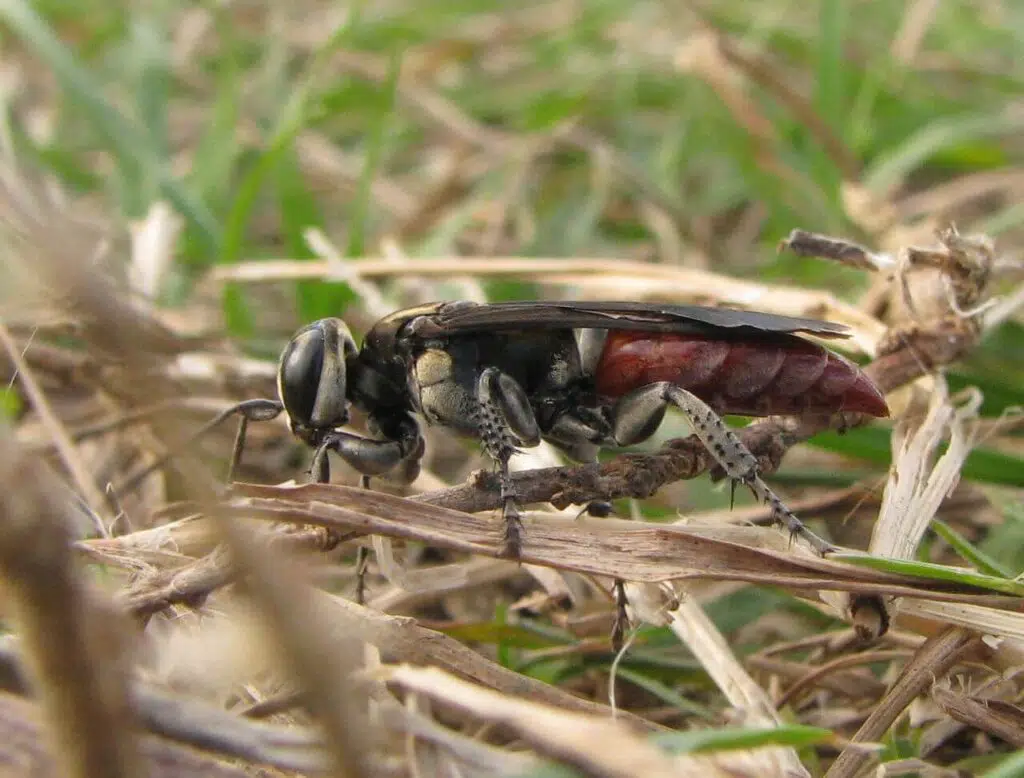
The larra bicolor wasp is a parasitoid wasp that is native to South America and was introduced to Florida as effective biological pest control of the invasive mole crickets.
As adults, these wasps feed on nectar, with shrubby false buttonweed being their favorite.
Females hunt the mole cricket, stinging them to paralyze them for a few minutes, while she deposits a single egg between the legs of the cricket. The cricket returns to its burrow. When the wasp larvae hatch, it feeds on the host.
Chlordane was banned in Florida in 1978 which left a problem on how to control the pest mole cricket. The University of Florida came up with an alternative, which was the introduction of larra bicolor, which has now spread through most of the state and into neighboring states.
They are highly adapted, non-aggressive with a mild sting when compared to the native wasps in Florida.
19. Ringed Paper Wasp
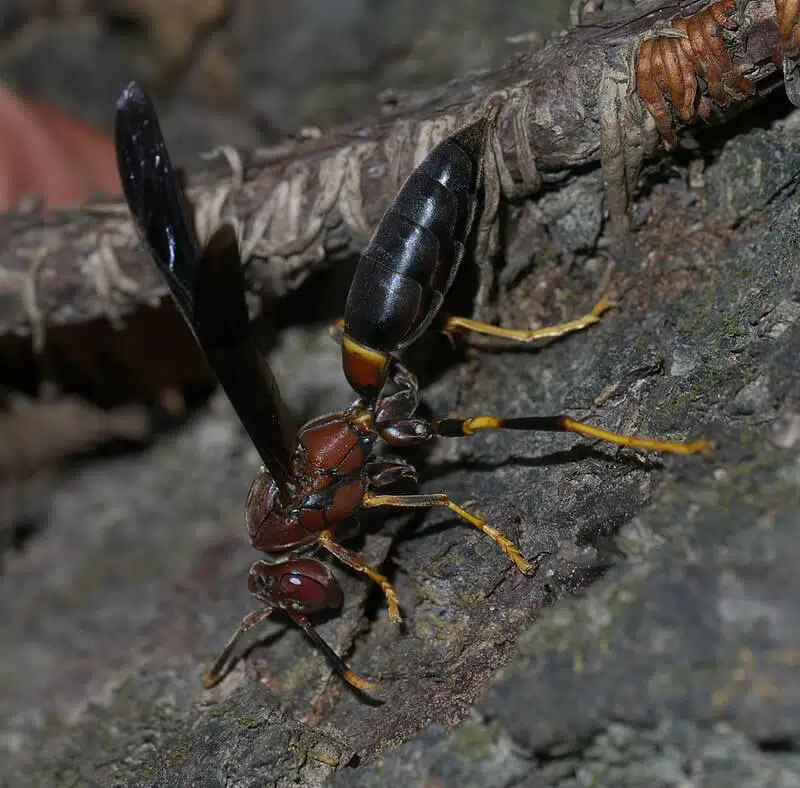
Ringed paper wasps (Polistes annularis) are found throughout the eastern parts of the United States. They are large, red and black wasps that build nests under overhangs close to the water with little sunlight.
Their primary diet is nectar and insects.
They have bright orange antennal segments. The head, thorax, and abdomen are mostly black with a single yellow ring at the end of the first segment. Their legs can range from black to a red rust color.
Females have long fore wings of around 23.5mm, while males’ fore wings can grow to 19.5mm.
They build nests in shrubs and tree branches, sometimes in sheltered areas of man-made structures. They are known to group their nests, which are often under an overhang, such as a rocky cliff.
They are never far from water.
20. Great Golden Digger Wasp
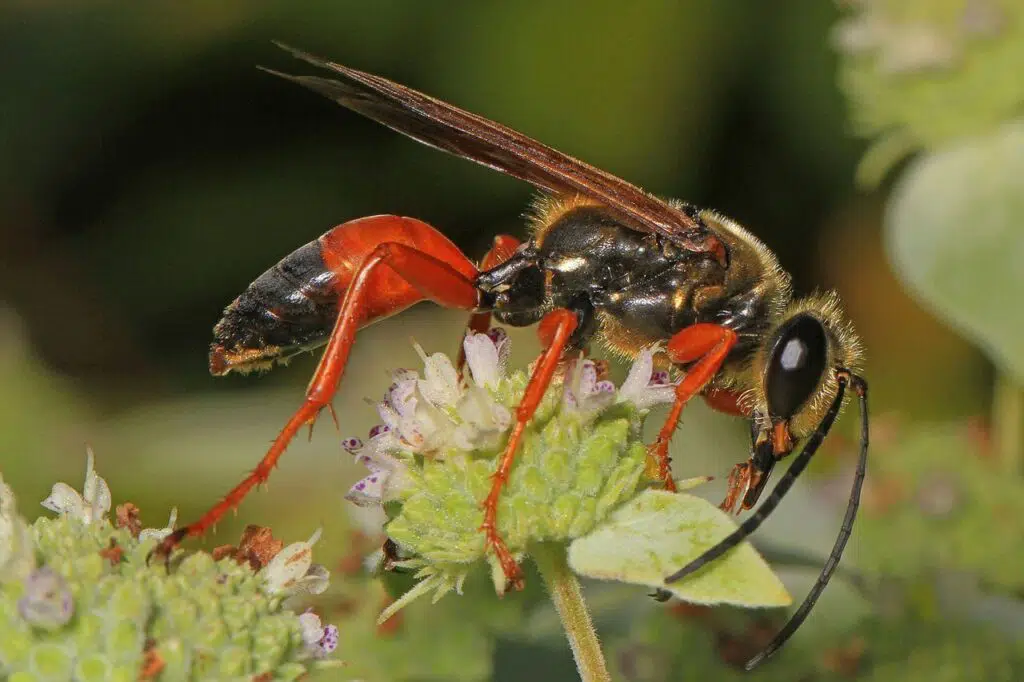
The great golden digger wasp (Sphex ichneumoneus) is not an aggressive species. As long as you mind your own business, it will leave you alone, as it drinks the nectar of flowers.
The female digs in loose soil, creating deep tunnels. Once her nest is ready, she preys on small insects, stinging them and carrying them back to the nest. She places the insect head first into the nest and lays an egg on the insect and covers it. She repeats this with each of the tunnels.
It’s not uncommon to see birds try and steal the prey.
These are beautiful wasps with orange and black color and interesting behavior.
21. Four-toothed Mason Wasp
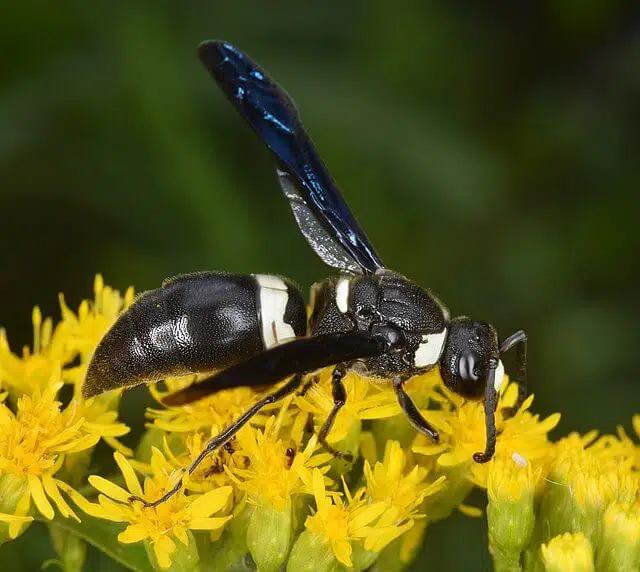
The four toothed mason wasp (Monobia quadridens) is a solitary potter wasp that rows to 0.71 inches (18mm) in wingspan, feeding on pollen and small caterpillars. They have black abdomens with a wide ivory band.
Like most wasps, the female four-toothed mason wasp can deliver a sting. The males can give a painful needle prick, but they do not inject any venom. The males, interestingly, don’t have a stinger and use the tip of their abdomens.
22. Caribbean Scoliid Wasp
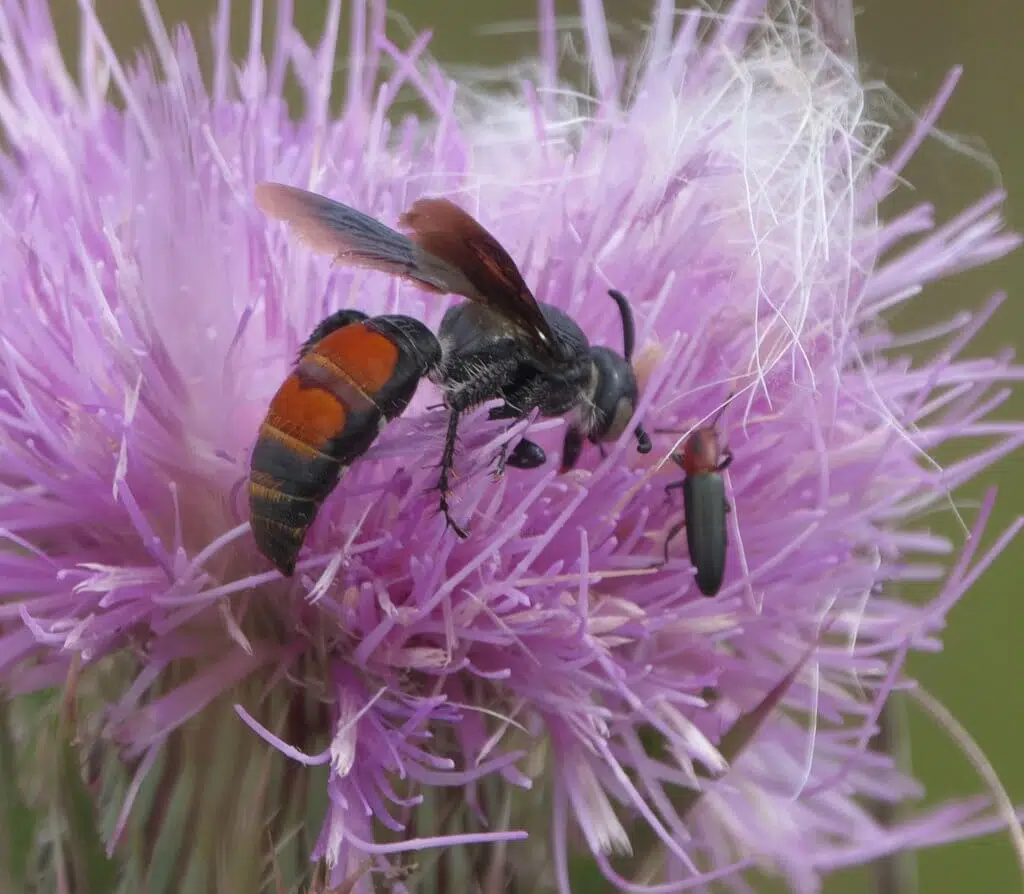
The Caribbean scoliid wasp (Dielis dorsata) was introduced to Florida to help with sugar cane pests. They are still valuable biological control of white grubs in sugar cane and for turf production and maintenance.
They were first introduced in the 1930s and are well established in Florida.
These are parasitic wasps of the Scarab beetle. They burrow into the earth and sting the beetle larvae, laying their eggs in the larvae.
They are more common in Miami-Dade county, the greater Tampa area, and Oceola County. None were found in Palm Beach County.
23. Slosson’s Mason Wasp
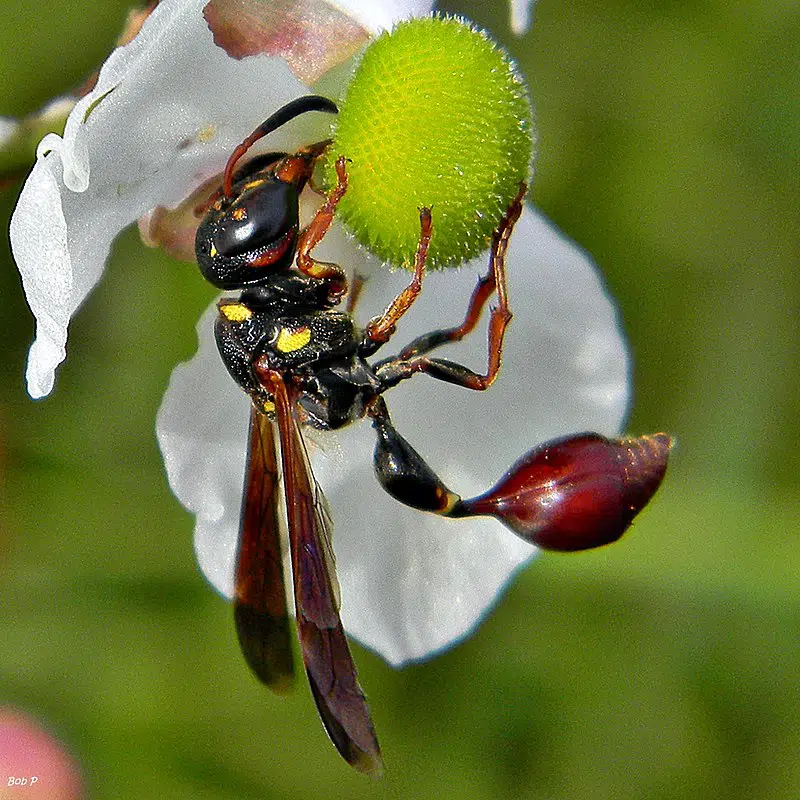
The Slosson’s Mason Wasp (Zethus slossonae) or Slosson’s Mason wasp is a stinging wasp, belonging to the Vespidae family, named by Annie Turnbull Slosson, who was an extensive collector in Florida in 1892.
They range from Florida to Orlando and Keys where females provision their nests with caterpillars, for the larvae to eat from.
They are striking red, yellow, and black.
24. Common Thread-waisted Wasp
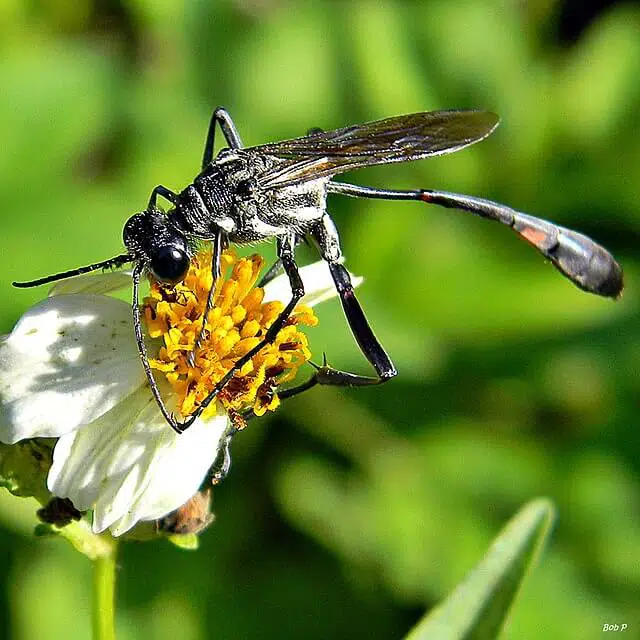
This wasp (Ammophila procera) has a narrow waist and is glossy black with a bulging abdomen that has a red or orange band near the very narrow waist. Their legs are skinny and long, in black.
They are ambush predators that attack and immobilize prey with their sting. They use their powerful jaws to carry or drag the victim to their underground burrow.
They make their nests in loose dirt.
A single egg is laid on the paralyzed insect, which feeds the larvae. Adult common threat waisted wasps feed on flower nectar and small insects.
They are not aggressive but are known to give a defensive sting if you accidentally stand or sit on one.
25. Ammophila pictipennis
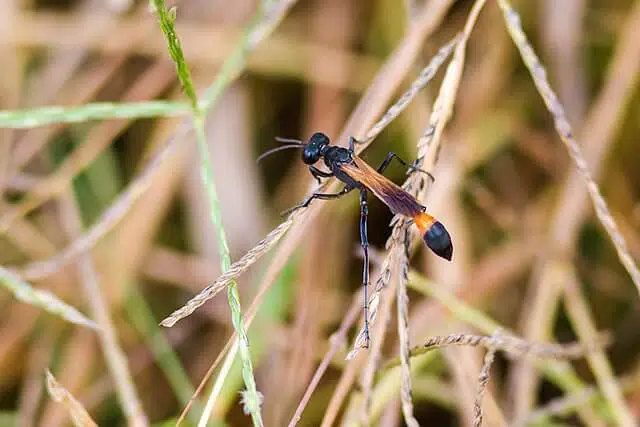
The Ammophila pictipennis is an eastern species with bright orange wings and no silver markings on its thorax.
They are mostly seen on flowers in fields, where they feed off the nectar.
They are most common in the summer months and are parasitoids of caterpillars.
They place prey in shallow nests, which contain one egg, which enables the larva to eat off the caterpillar when they first hatch.
26. Nearctic Blue Mud-dauber Wasp
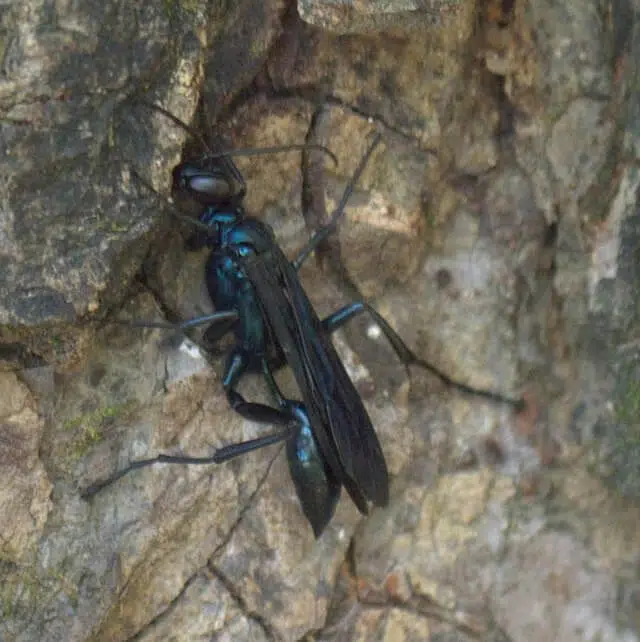
The nearctic blue mud dauber wasp (Chalybion californicum) is metallic blue and a primary predator of the venomous black widow spider.
Females build nests, sometimes refurbishing an abandoned mud dauber wasp nest.
They are not aggressive and the males do not have a stinger. Females will sting as a defense.
Adults feed on flower nectar, pollinating wildflowers as they fly. The larvae feed on spiders. These wasps hunt on the ground and under rocks looking for spiders to add to their nest for their larvae to feed on.
Note: some spiders also hunt and eat wasps. Check out the list of common spiders that eat wasps.
27. Eastern Yellowjacket
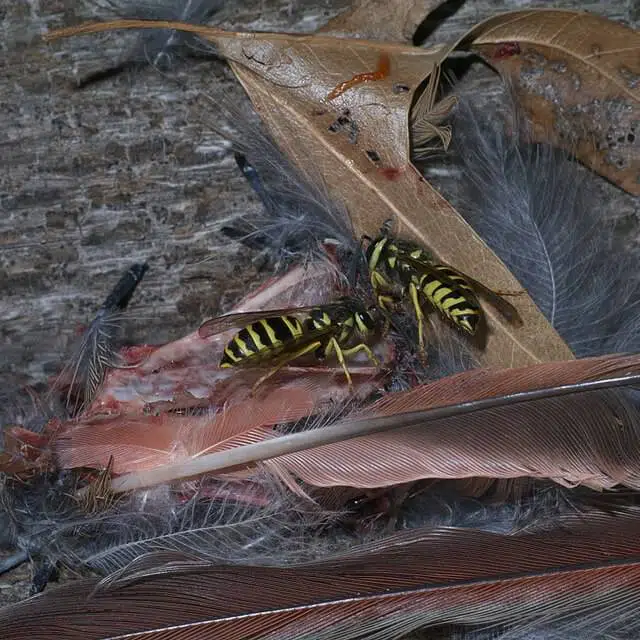
Eastern yellow jackets (Vespula maculifrons) are found in eastern North America and are often considered bests for creating nests in recreational areas and man-made structures.
They are very social, known for living in large colonies of thousands. They will aggressively defend their nests and are known for their painful stings.
They are small wasps recognizable with black and yellow lines on their abdomen, head, and thorax. They have curved bodies and can grow to 0.625 inches (15.9mm) in length, weighing up to four grams.
They build nests up to 11.8 inches in diameter, allowing for thousands of workers. They create nests out of worn and decayed wood.
They are found on sites above the ground, including buildings. You may see one of their nests on creek bands and in forests, along with urban and suburban areas. They choose sheltered areas, such as attics and tree stumps.
28. Bahamian Paper Wasp
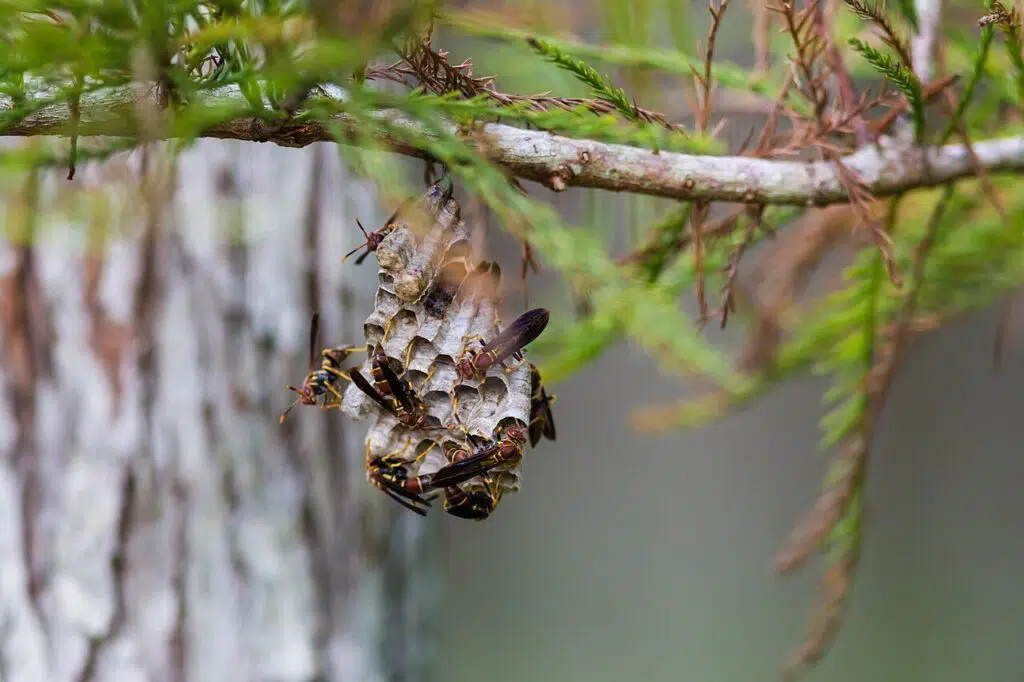
The Bahamian paper wasp (Polistes bahamensis) has a yellow spot on the back and a developed yellow marking on the mesosoma. They are not easy to identify.
They have been in Florida since the 1930s when they were first recorded here. They were reported again in 1983 where they have been building nests throughout Florida to Louisiana.
29. Metallic Bluish-green Cuckoo Wasp
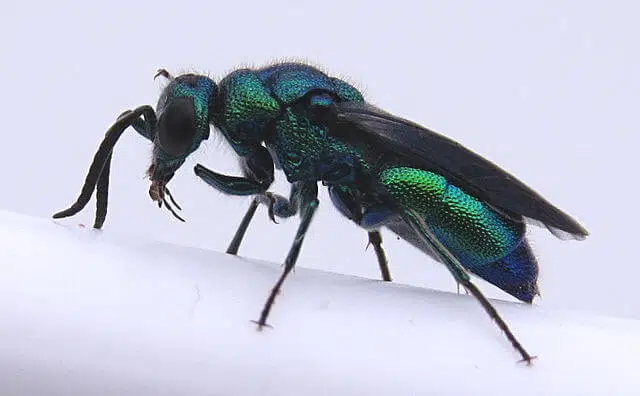
The metallic bluish-green cuckoo wasp (Chrysis angolensis) is an invasive and parasitic wasp, introduced to North American during the Second World War.
They have a blue to green colored head, thorax, and abdomen, which have metallic reflections. The abdomen comprises of four segments in males and three segments in females. They have large eyes on the side of their head and three small eyes in a triangle pattern on their head. They have short black antennae.
30. Four-banded Stink Bug Wasp
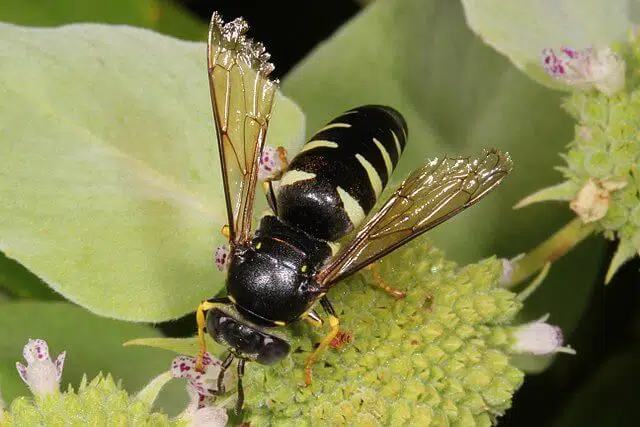
The four-banded stink bug wasp (Bicyrtes quadrifasciatus) grows to 19mm and is often seen foraging on flowers. Females paralyze true bugs to provision their nest.
These are large sand wasps, common in Floria.
They have an exoskeleton plate that covers the first segment of the thorax. The plate on the upper side of the mesonotum is solid black without any yellow markings.
They have a black abdomen with females having four pairs of spots and males having five pairs of spots. The spots for a band, which is broken in the middle. The spots of the last two bands are separated further apart than the others.
They have clear fore wings and yellow on their legs.
31. Keyhole Wasp
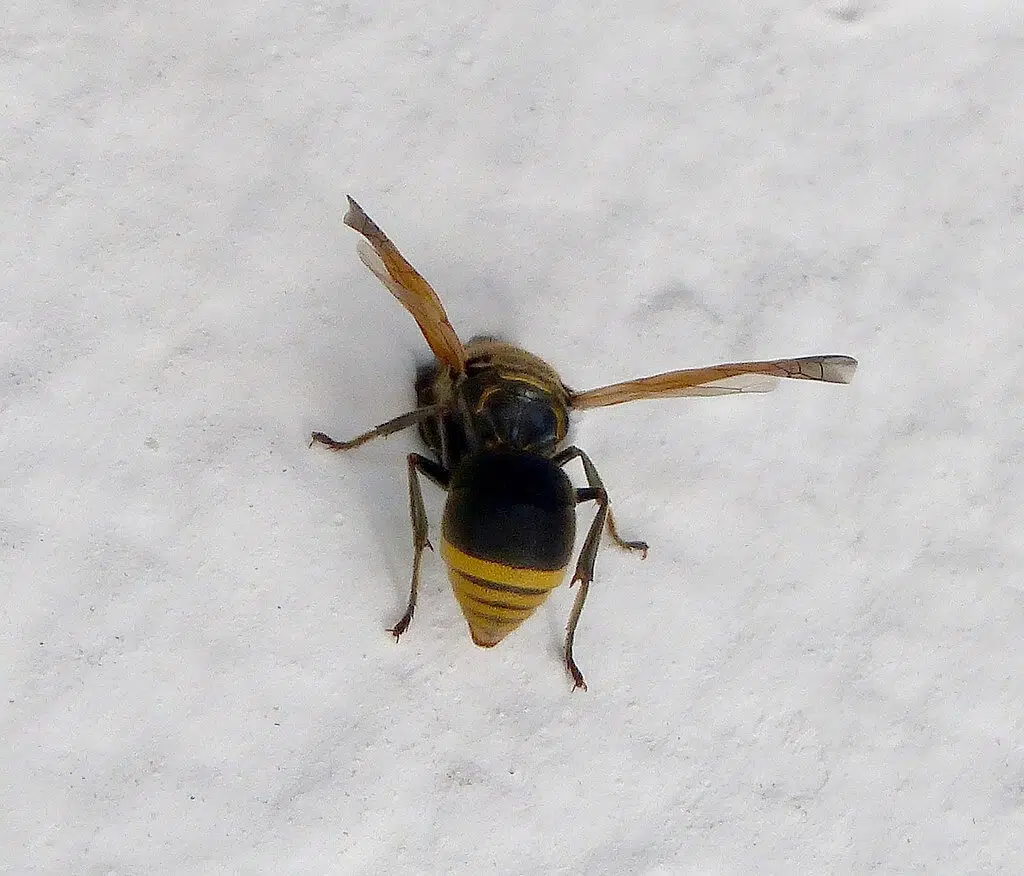
The Keyhole wasp(Pachodynerus nasidens) is a stinging wasp, belonging to the Vespidae family and was introduced to Northern America.
They are considered an aviation risk, due to the aircraft pitot tubes providing an attractive nesting place for these wasps. They visit shrubby false buttonweed, goldenrods, and swamp titi, drinking nectar from the plants during the day.
32. Zeta argillaceum
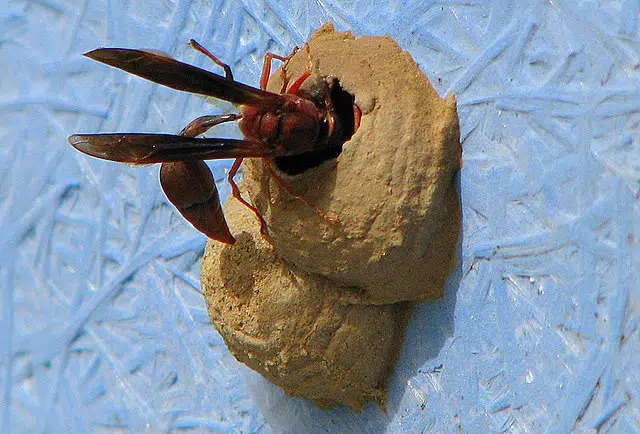
The Zeta argillaceum is one of the most common potter wasp species in the southern United States, where it was accidentally introduced. They adapt easily to changes in habitat and they create nests in groups, attached to urban building walls. The nests have a small single entrance hole.
33. Zethus spinipes
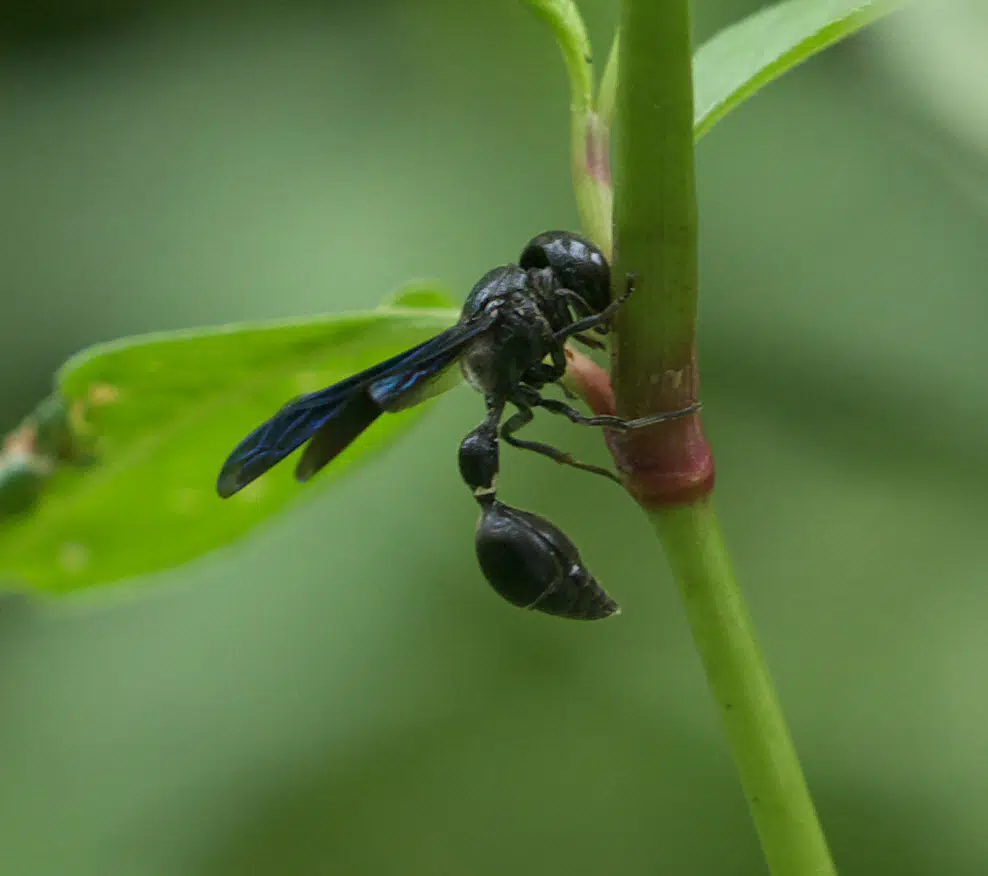
Zethu spinipes belongs to the Vespidae family and is a stinging wasp. They are often found where there are flowers, in fields and meadows with a fore wingspan of 14mm.
They can grow to 15mm in body length and visit late-flowering thoroughwort, gulf croton, and blazing stars. They feed during the day.
34. Gold-marked Thread-waisted Wasp
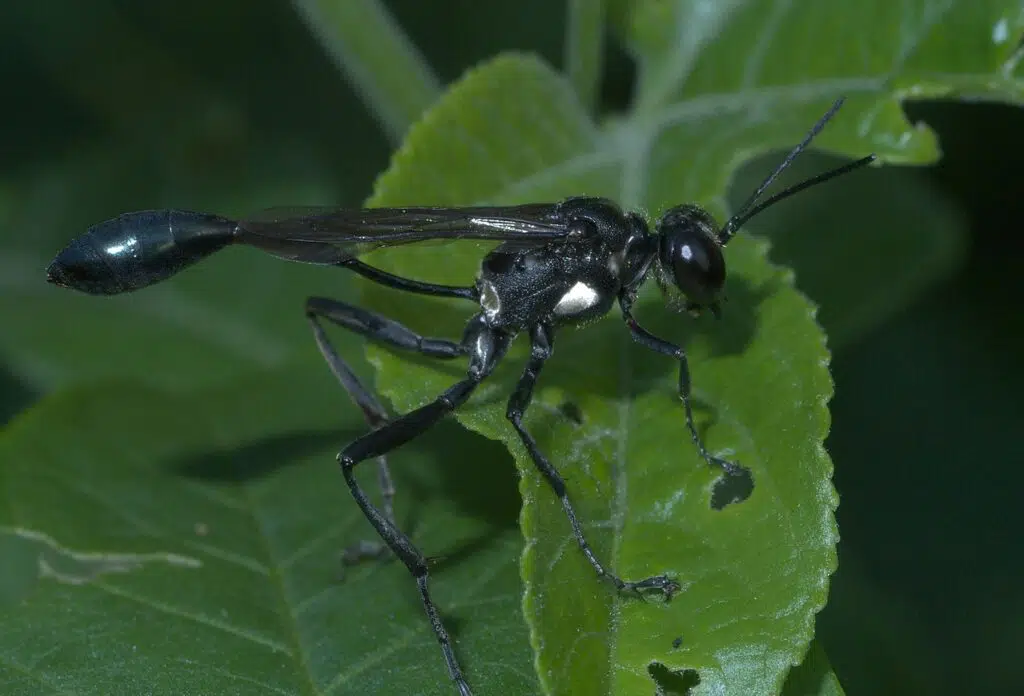
The gold marked thread waisted wasp (Eremnophila aureonotata) can grow to 22mm in length with a distinctive thread waist. They are black with blue reflections and two silver to gold patches on either side of the thorax and pair on the propoeum.
They are commonly found in old fields and close to woodlands where they are seen on wildflowers, drinking the nectar. Larvae feed on a number of insects, with preference given to the Notodontidae moth.
35. Organ-pipe Mud-dauber Wasp
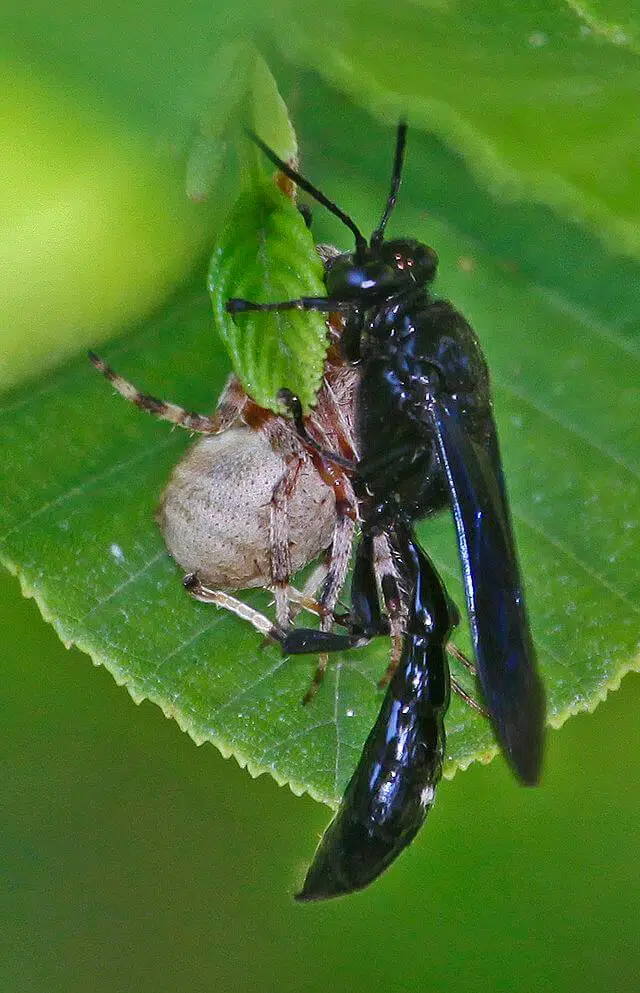
This is a predatory wasp, that is large and can grow to 5.1cm.
They are most common from May to September with females and males being very similar in color with shiny black and pale yellow to white back legs.
They feed on a number of spiders.
They usually construct their nets in tree holes and under bridges where there is a smooth vertical surface, plenty of shade, and mud nearby while being protected from the rain.
36. Jamaican Digger Wasp
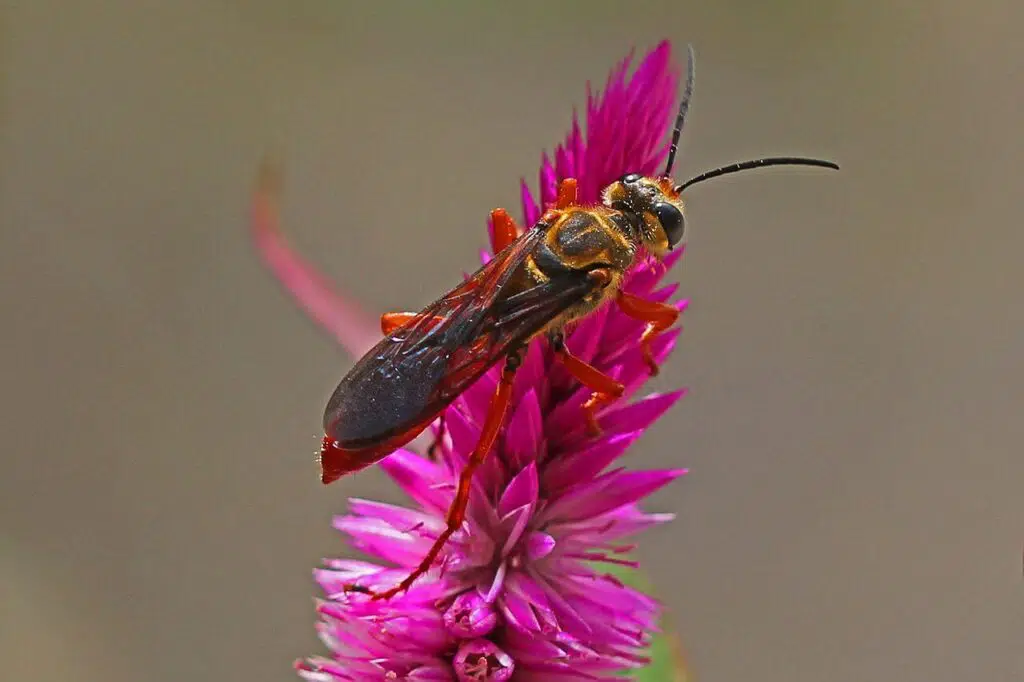
The Jamaican digger wasp (Sphex jamaicensis) is a common visitor to South Florida fields and parks. They are rusty orange with black wings, feeding on flowers.
They are solitary wasps and are abundant in warmer climates, forming nests by digging holes in the ground where they can lay their eggs and protect their growing wasps.
37. Rusty Spider Wasp
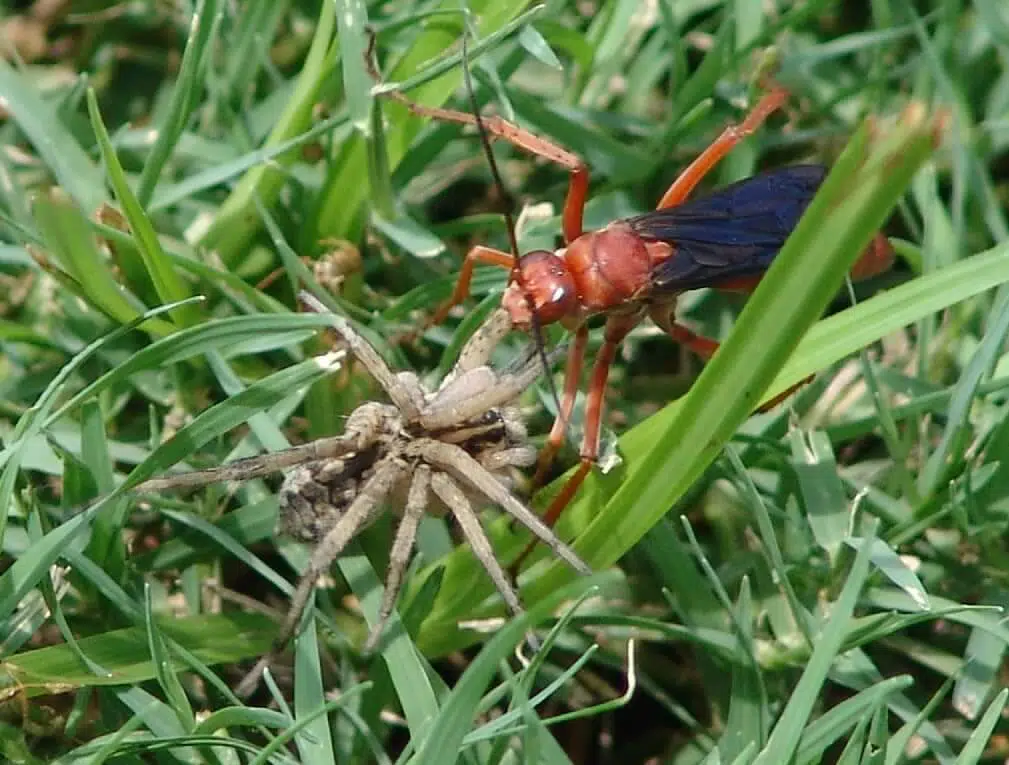
The rusty spider wasp (Tachypompilus ferrugineus) is a large red/orange colored wasp with indecent blue to violet wings.
They hunt large spiders, paralyzing them before they drag them back to their nest, offering them as food for offspring.
These wasps can grow to 25mm in length with females being larger than males.
They are not dangerous to humans and are often seen drinking nectar from flowers, digging in loose soil, or dragging a spider, larger than themselves, back to their nest.
38. Blue-winged Scoliid Wasp
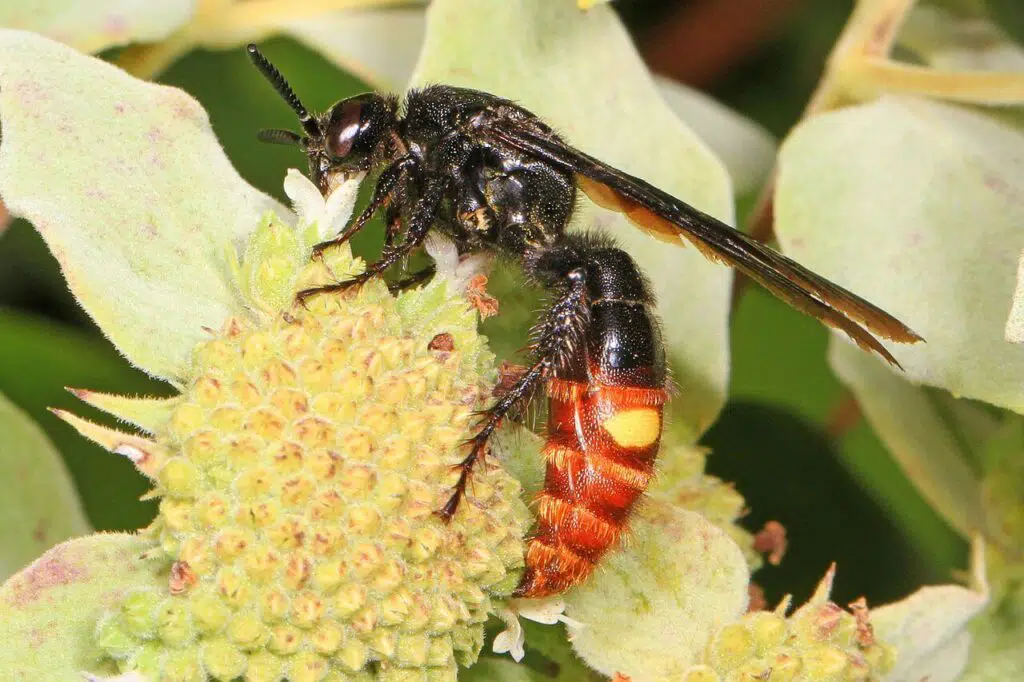
The blue-winged scoliid wasp (Scolia dubia), also known as the two-spotted scoliid wasp, grows to 1.0 inches (2.5cm).
They have black heads, thorax, and two abdominal segments with the remainder of the abdomen being red with two yellow dots o the third segment. They have blue-black wings and collect nectar from flowers.
Females are known to dig in the ground looking for beetle grubs. She then stings the beetle, burrows further to create a cell, and lays her egg on the host.
39. Fine-backed Red Paper Wasp
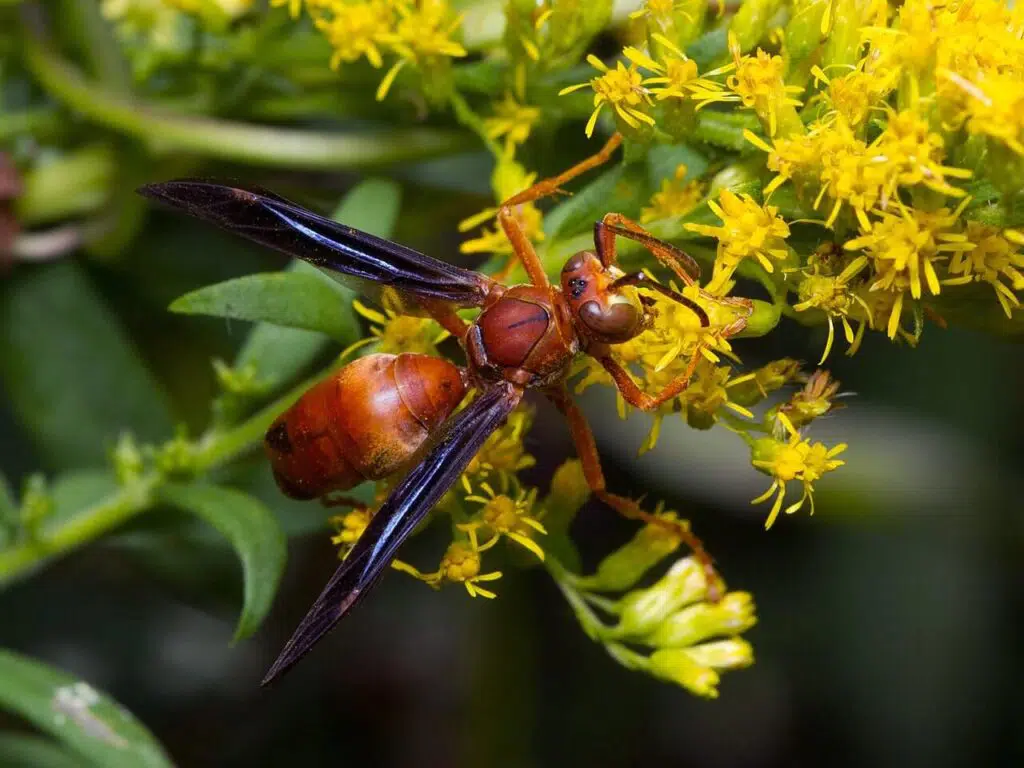
The fine-backed red paper wasp (Polistes carolina) can grow to 32mm in length with black wings. It is red to brown in color. They prefer protected areas to build their nests such as hollow trees. They will build their nest close to humans, including under the roof of homes.
40. Golden-reined Digger Wasp
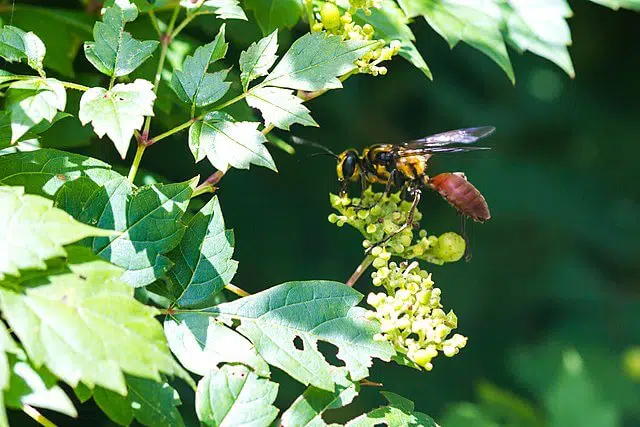
The male golden reined digger wasp (Sphex habenus) will grow to 29mm with females being slightly smaller at around 25mm. They have a dark abdomen with golden highlights around the face and thorax. They are mostly seen drinking nectar from flowers in fields from mid-summer to fall.
41. Double-banded Scoliid Wasp
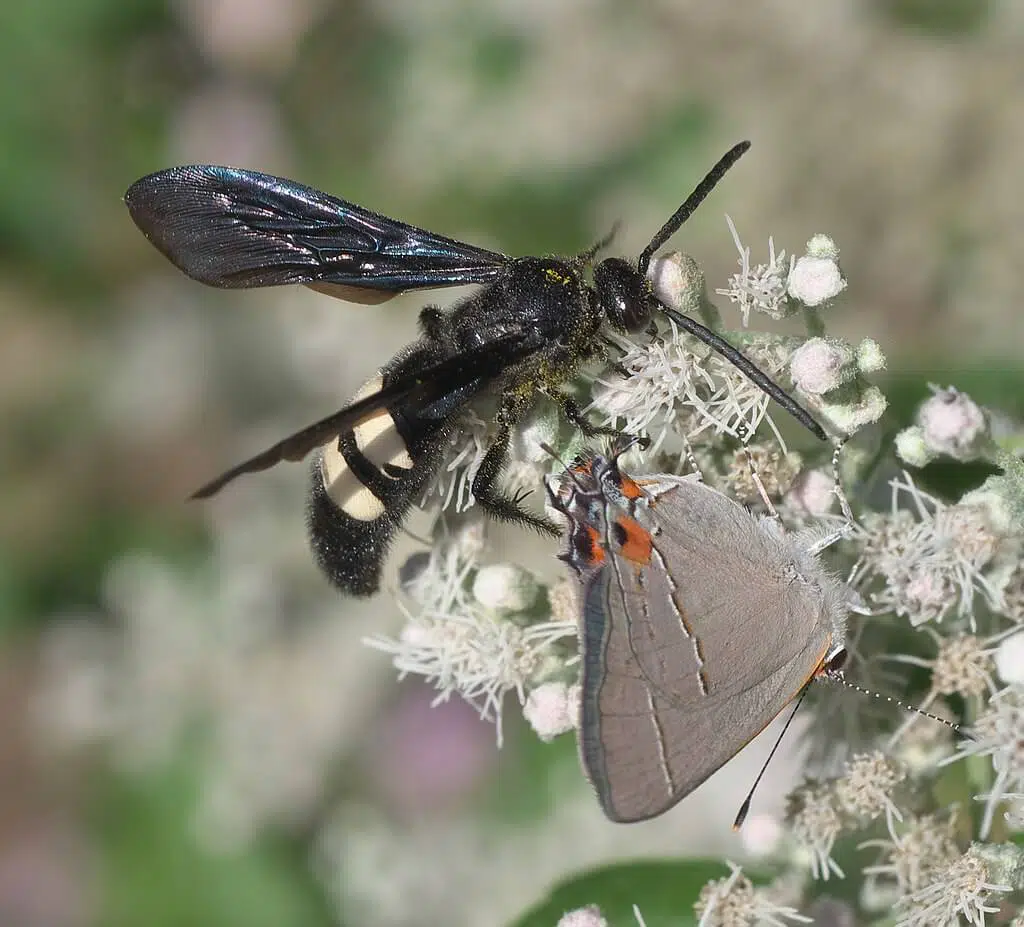
Double-banded scoliid wasps (Scolia bicincta) can grow to 25mm in body length. These medium-sized wasps are dark and hairy with two creamy white bands on their abdomens. They are often seen on flowers in fields in late summer.
42. Great Black Digger Wasp
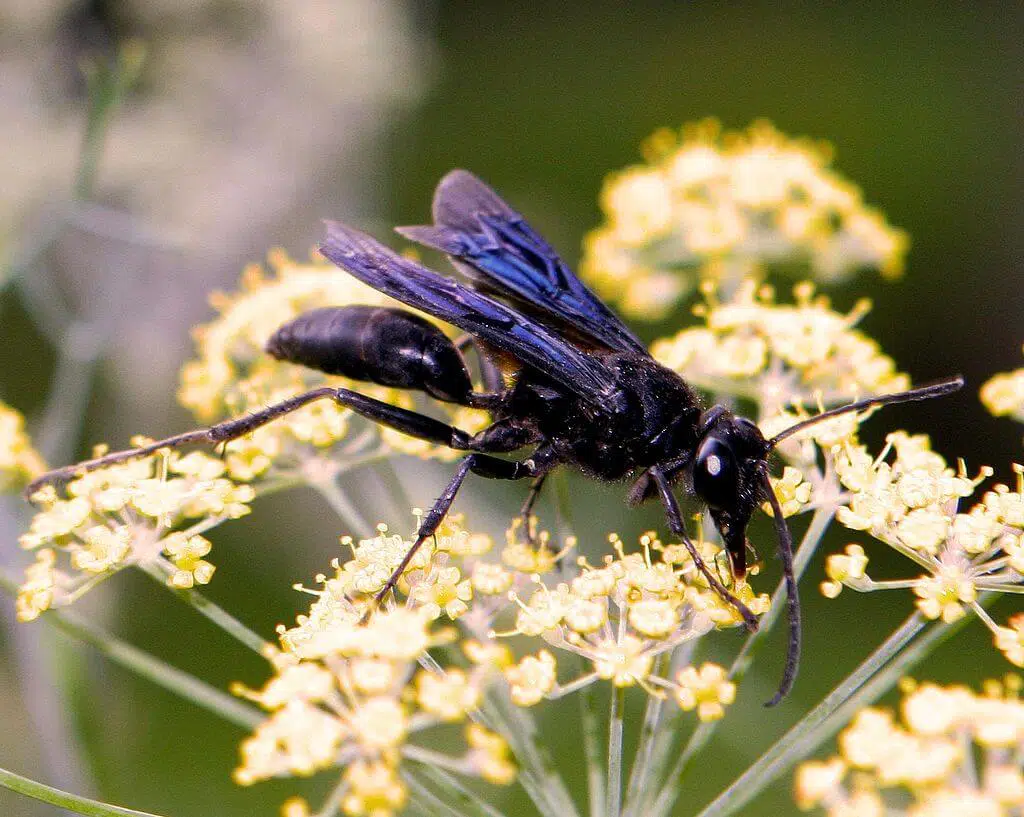
The great black digger wasp (Sphex pensylvanicus) can grow to 1.4 inches (35mm) in body length. They are large wasps with males being slightly smaller than the female. While their sting does not pack a powerful punch, it does cause swelling. They are dark in color with smoky-colored wings.
Further Reading: